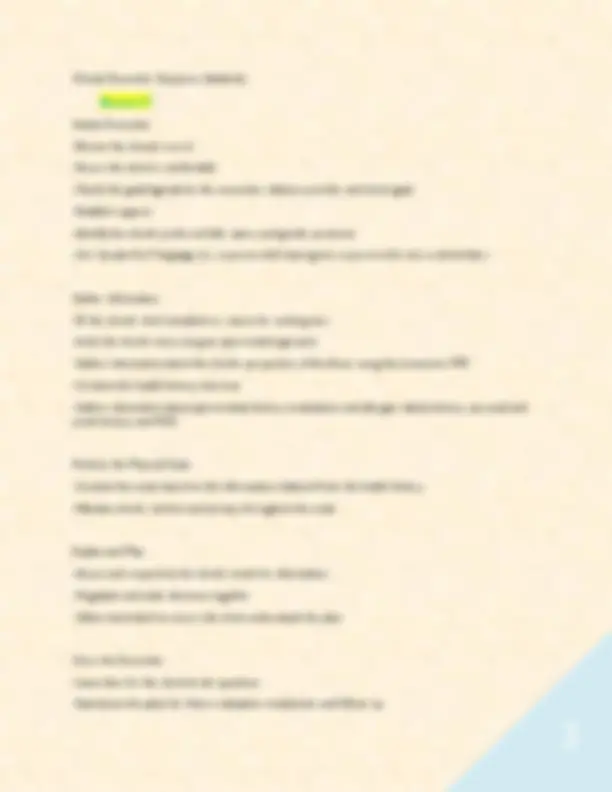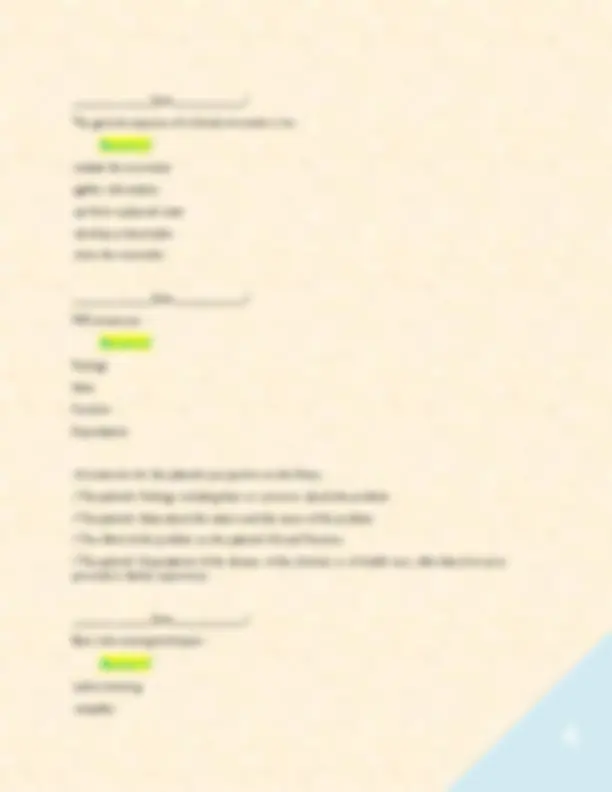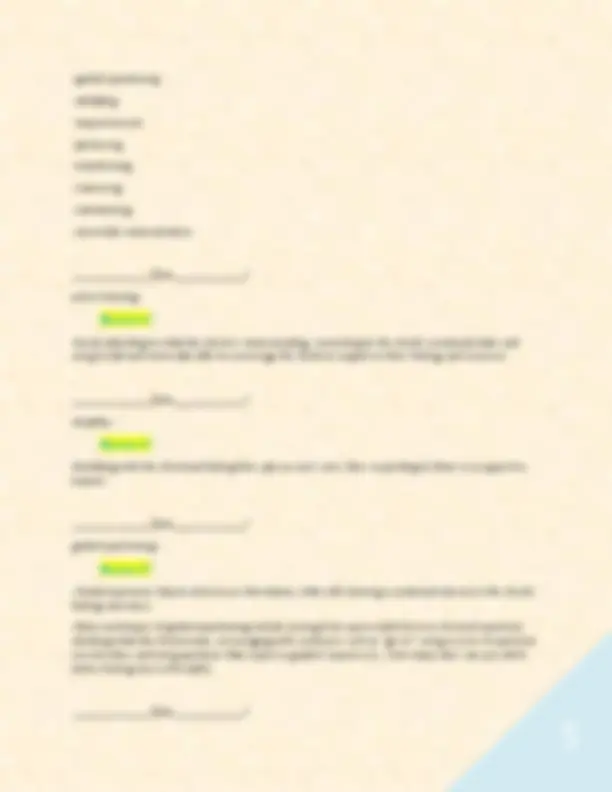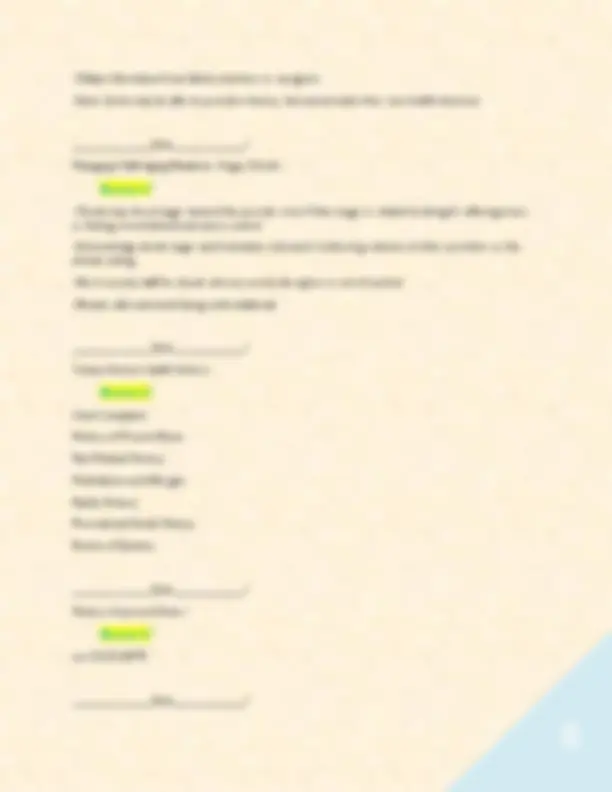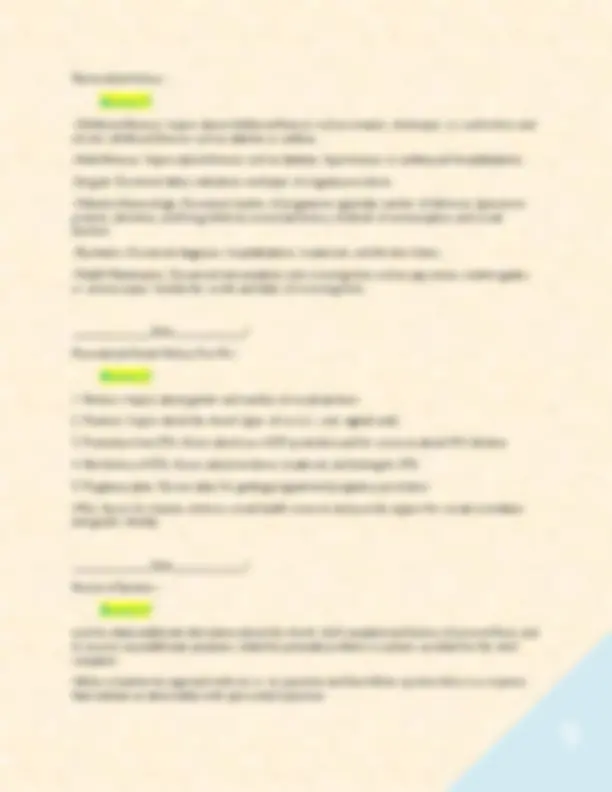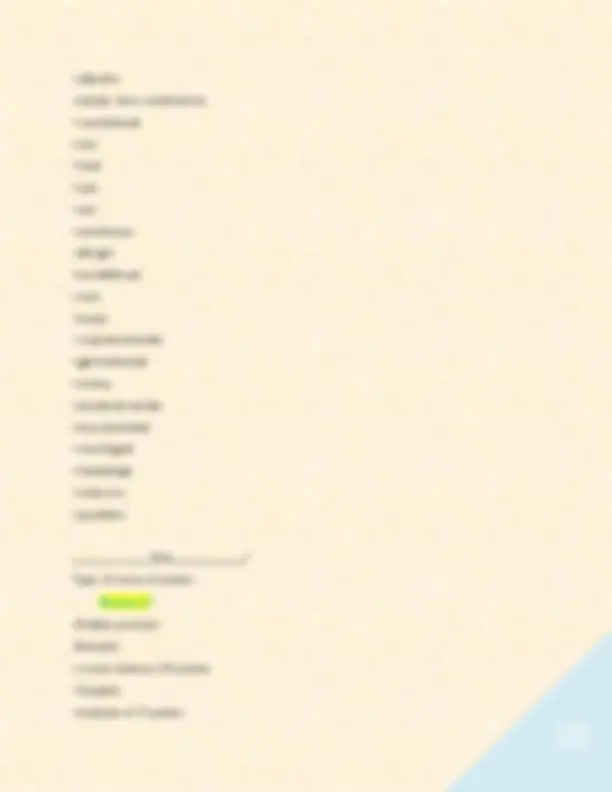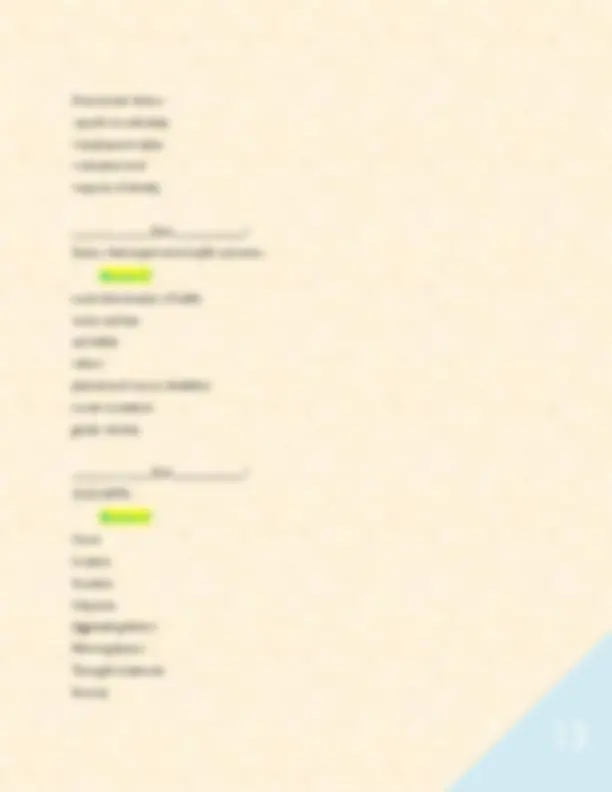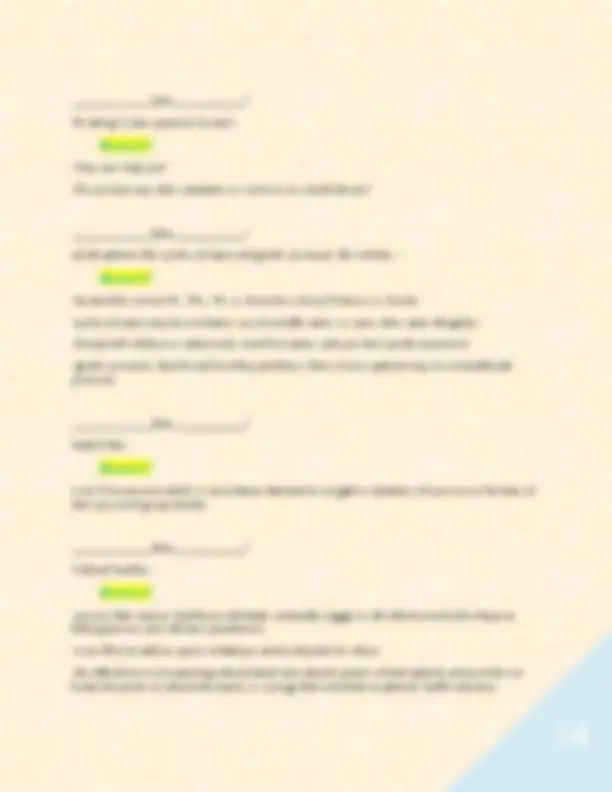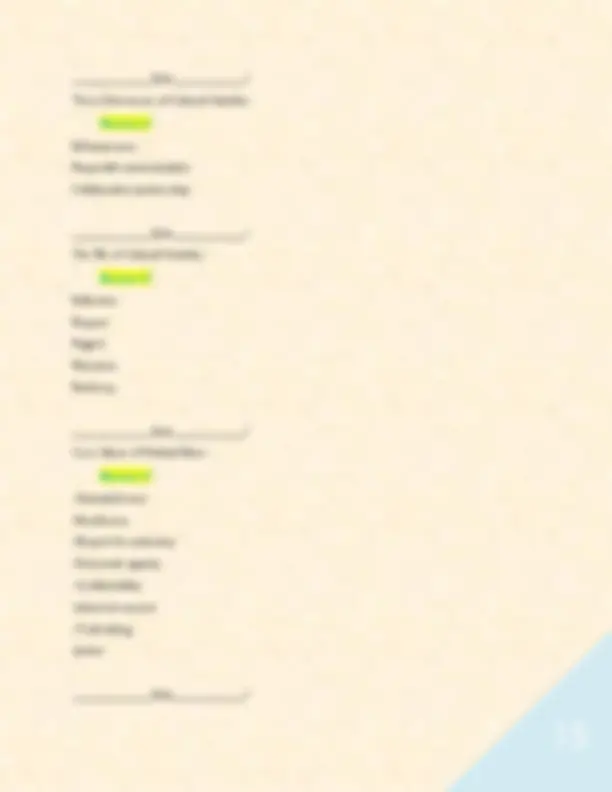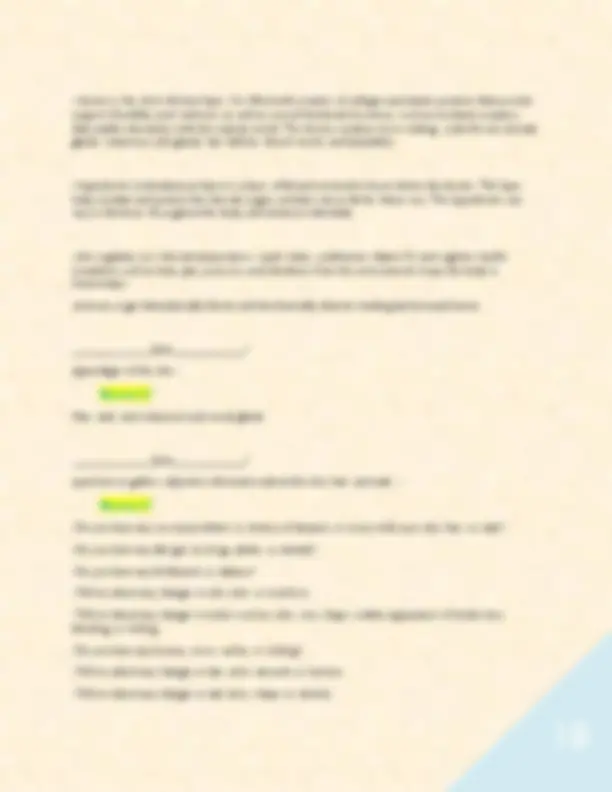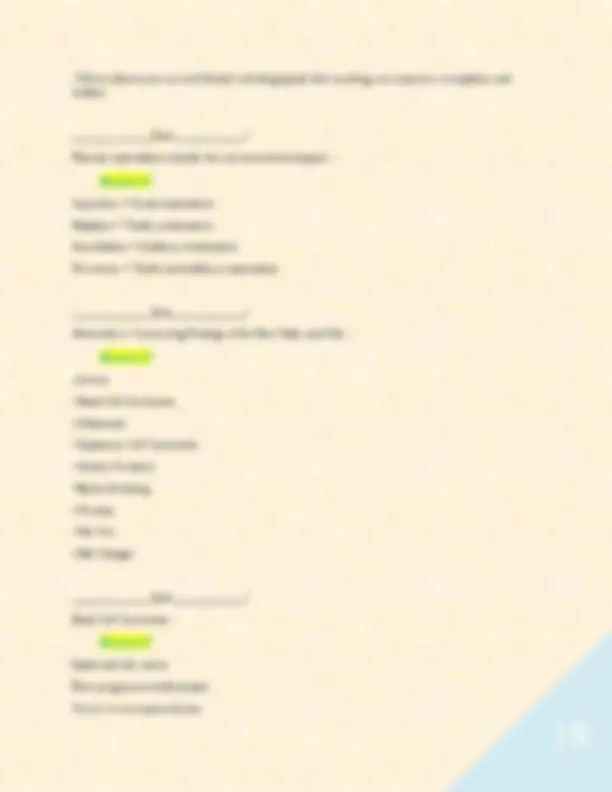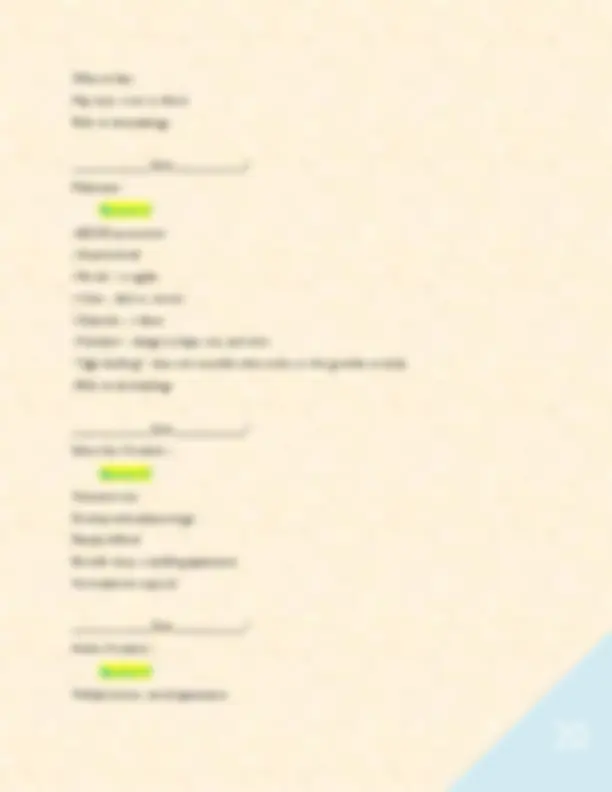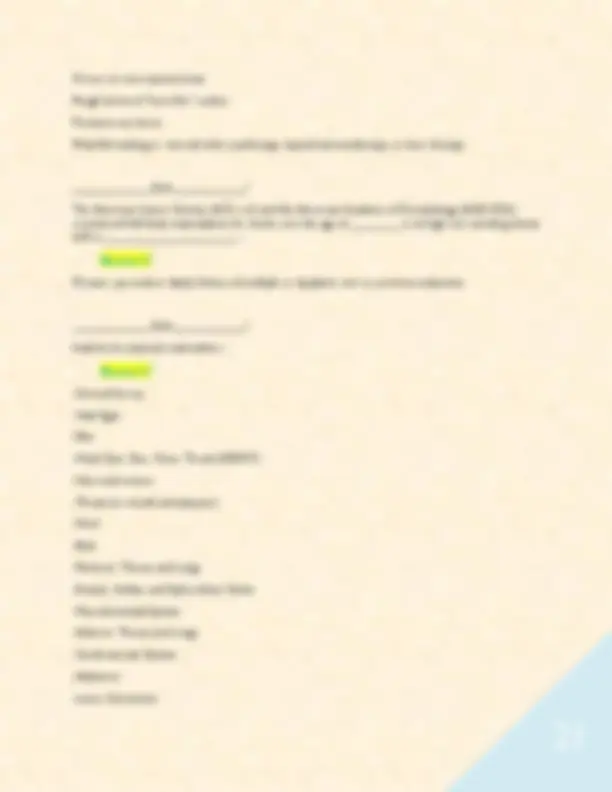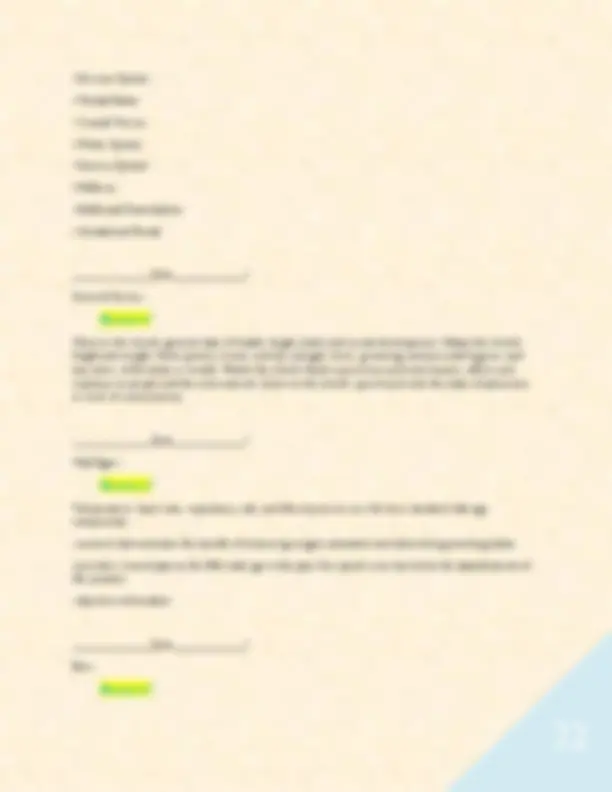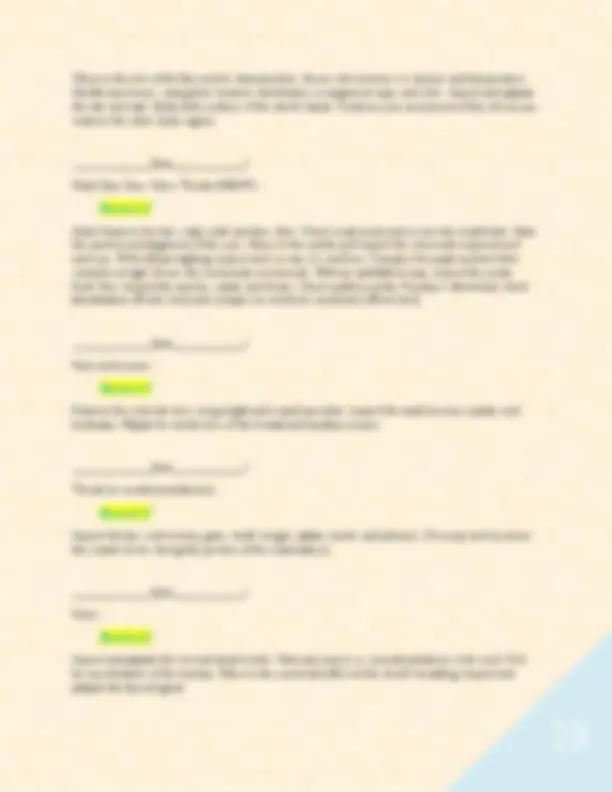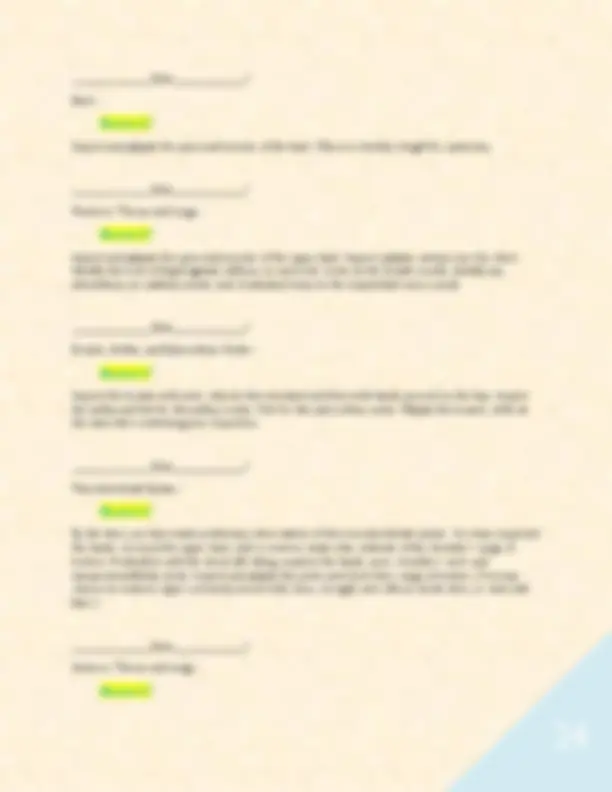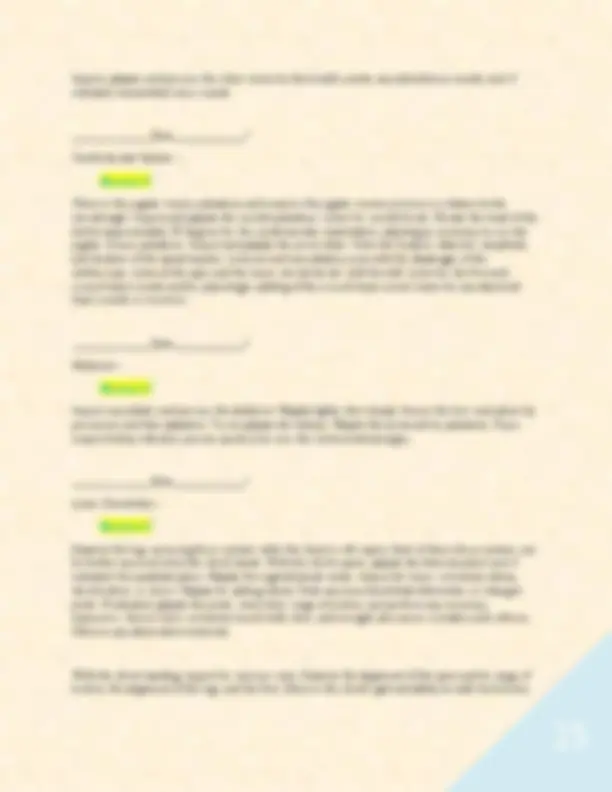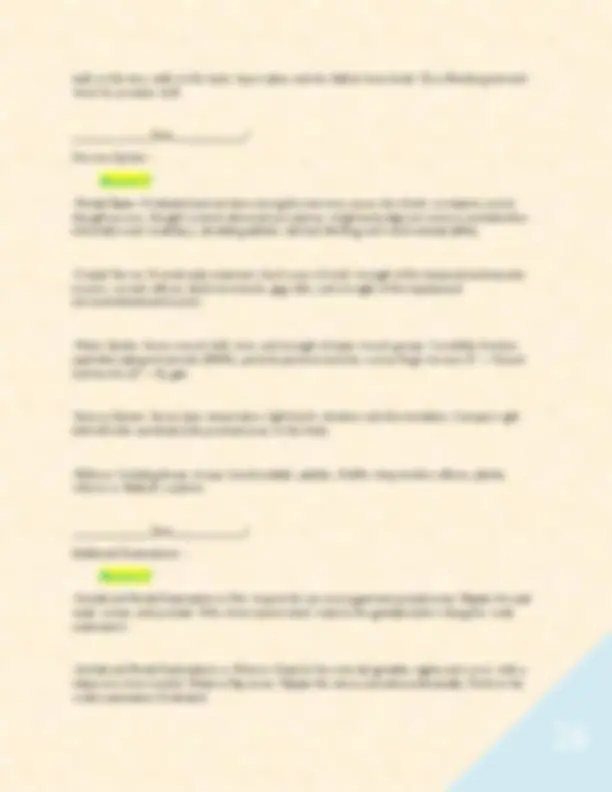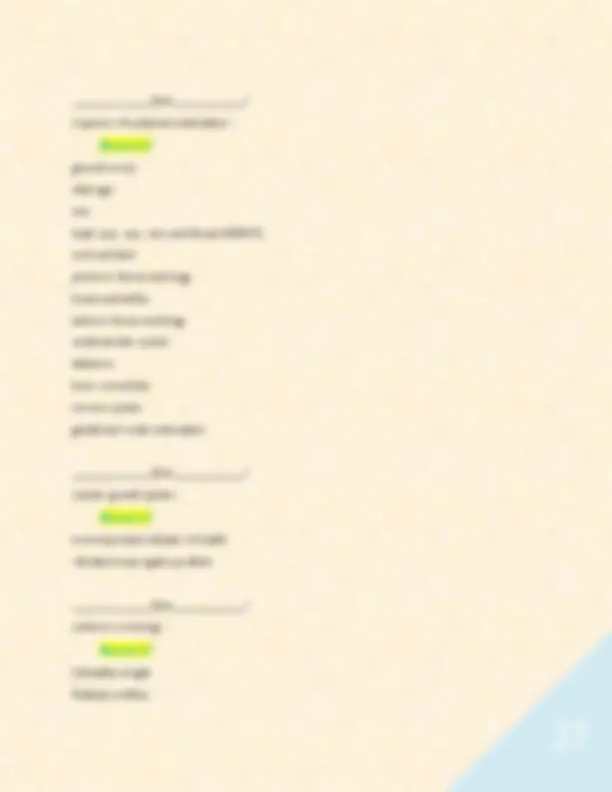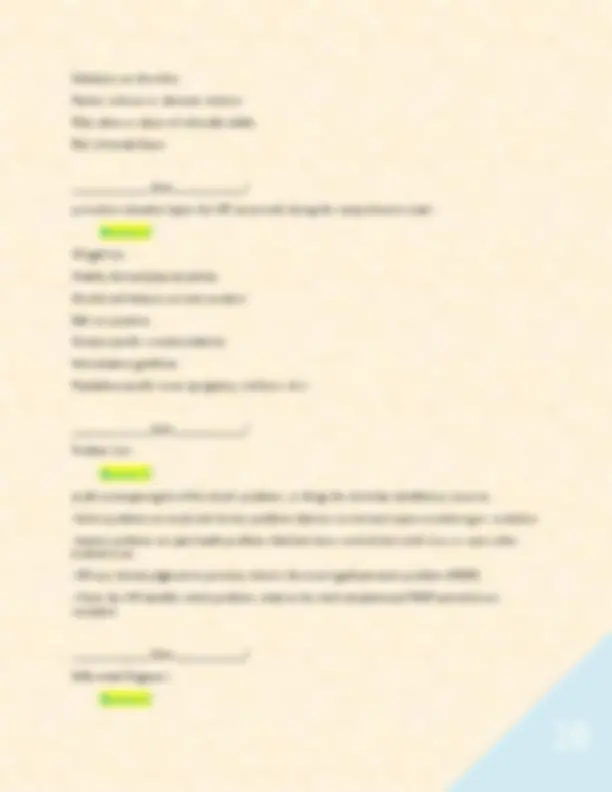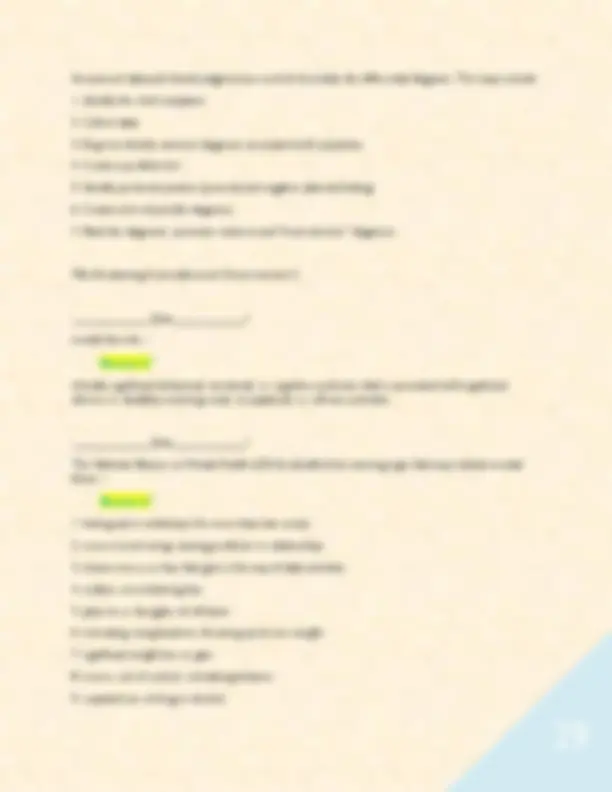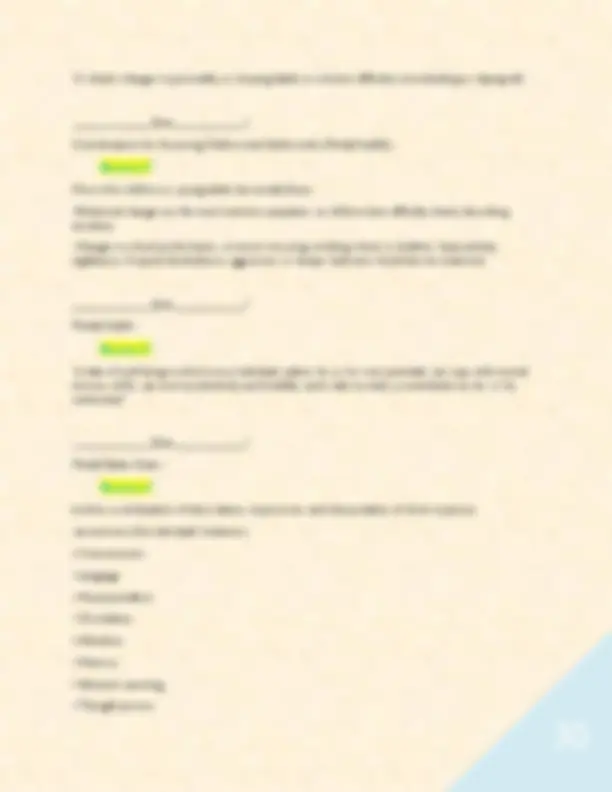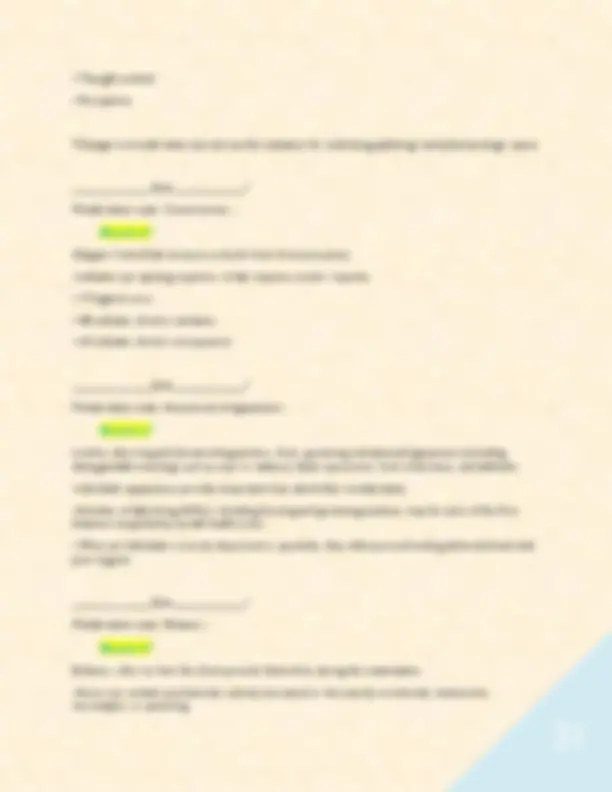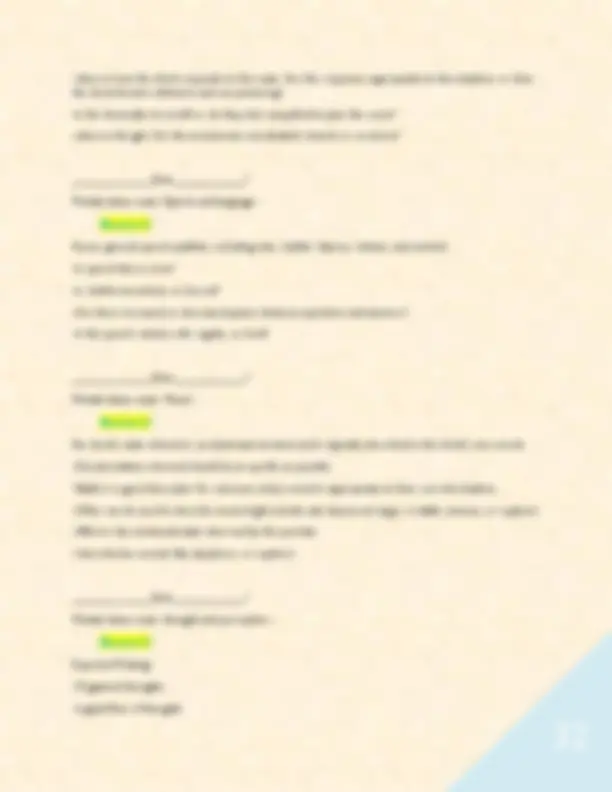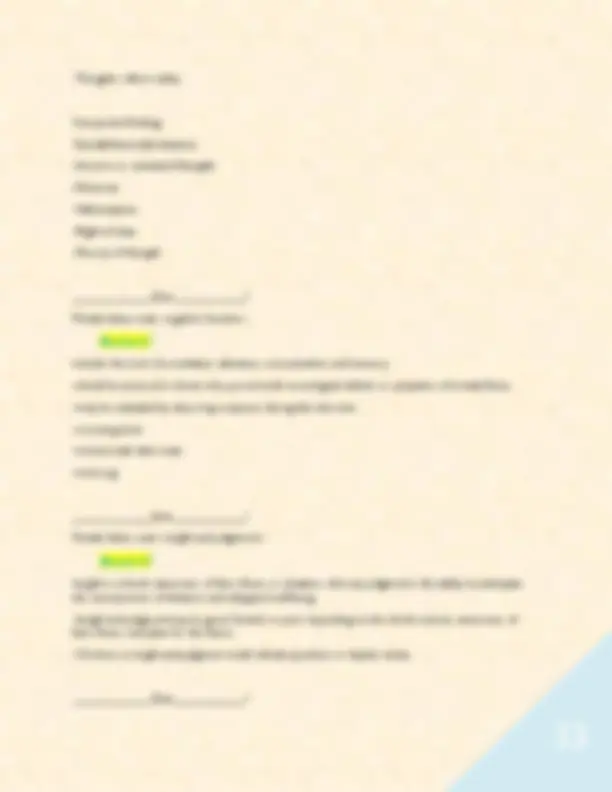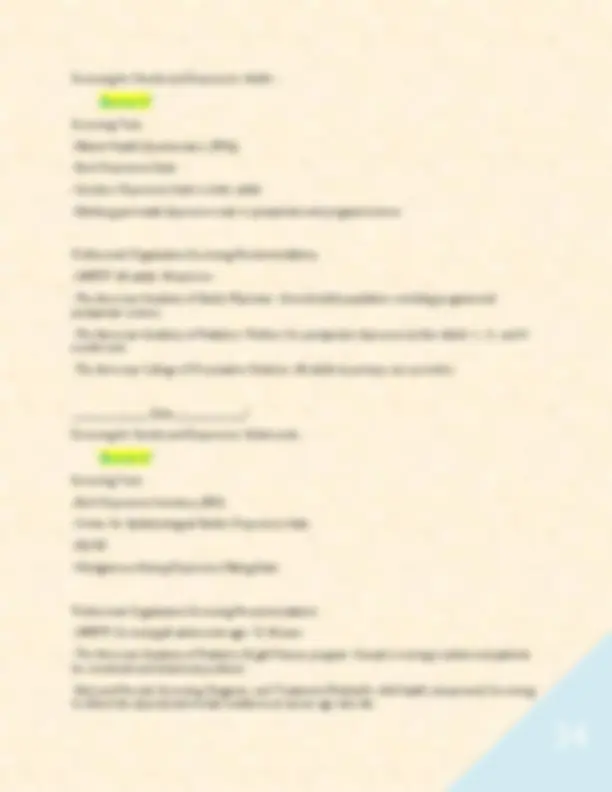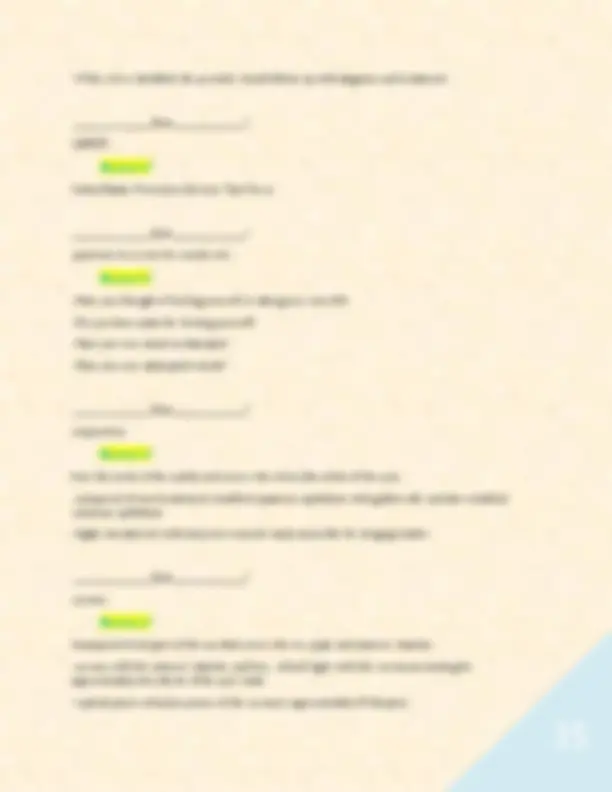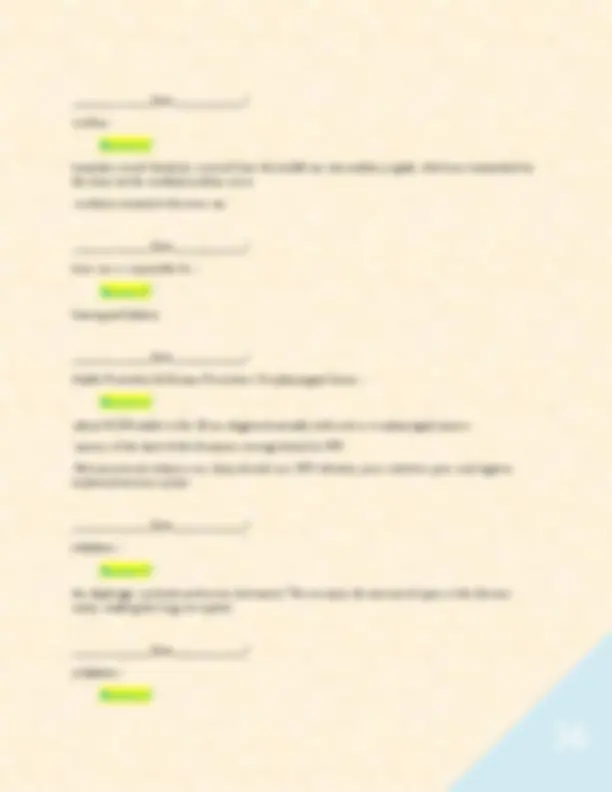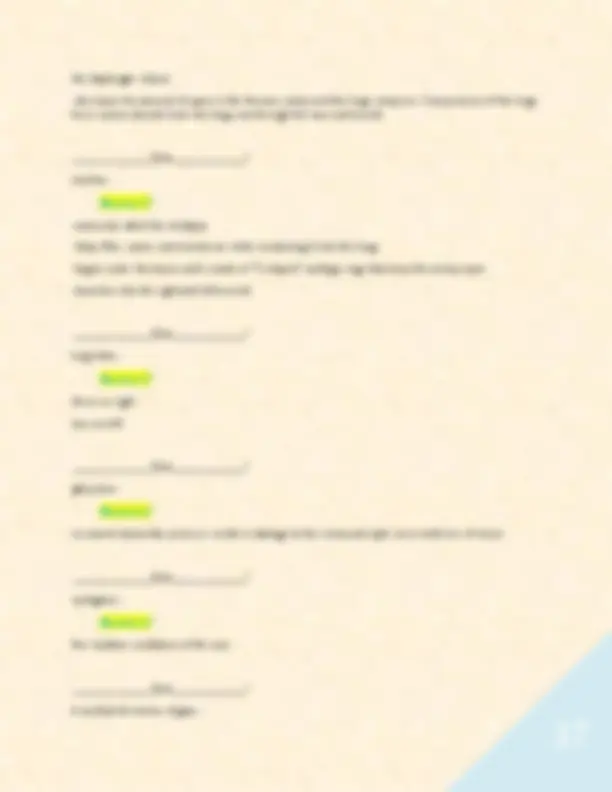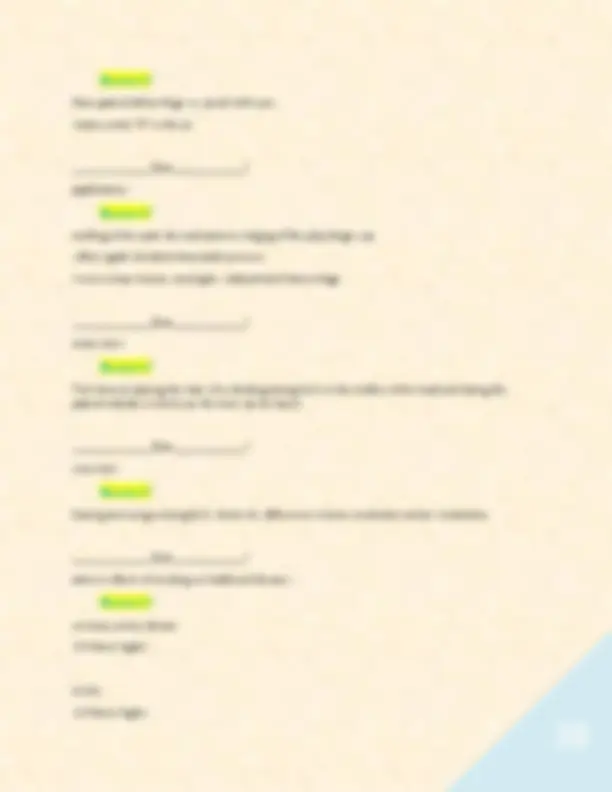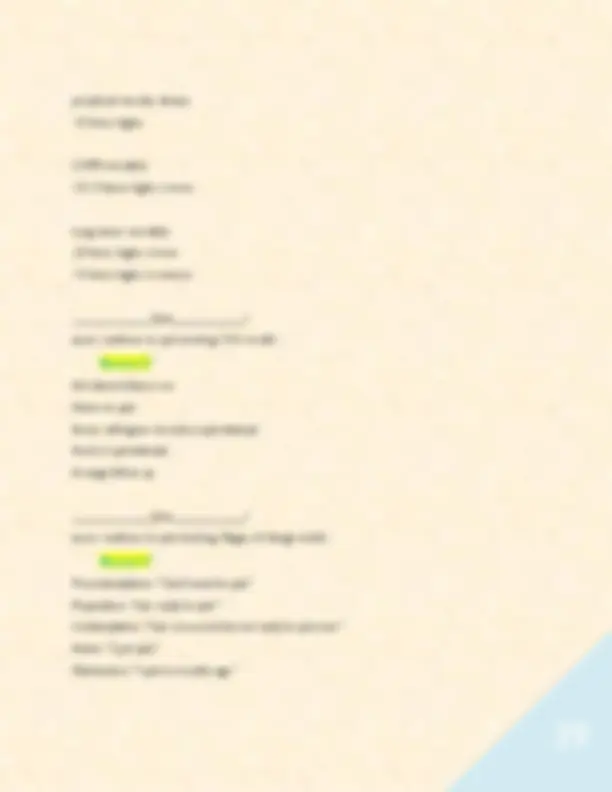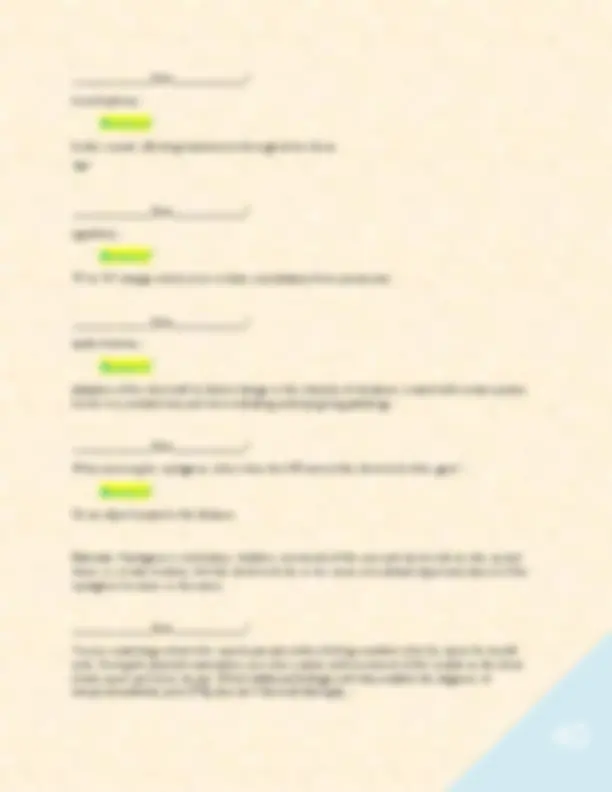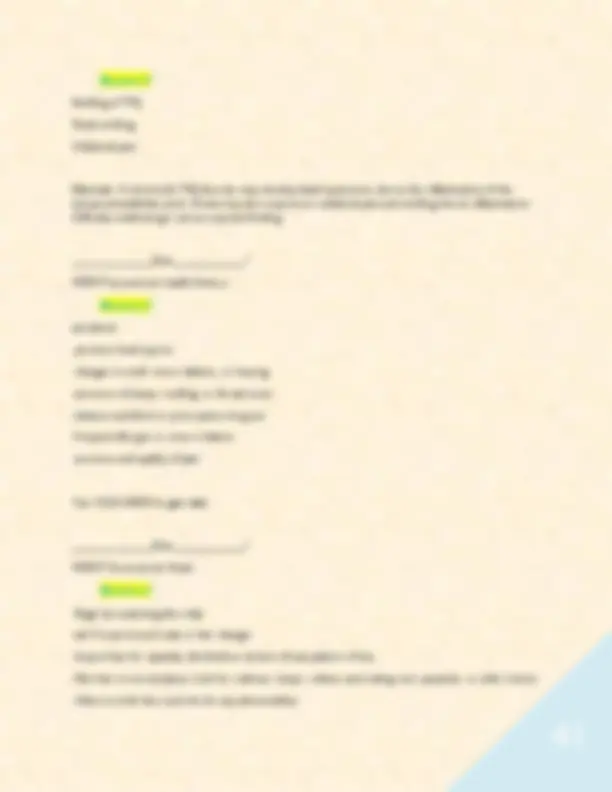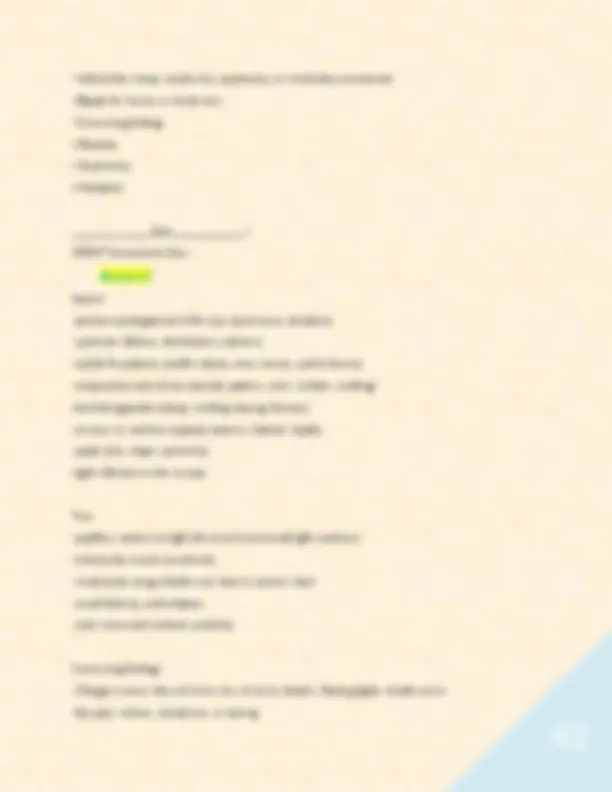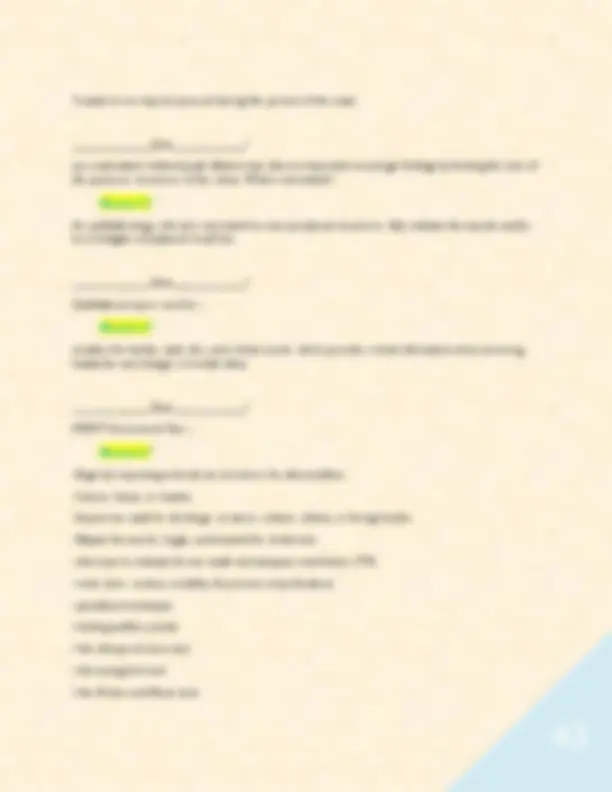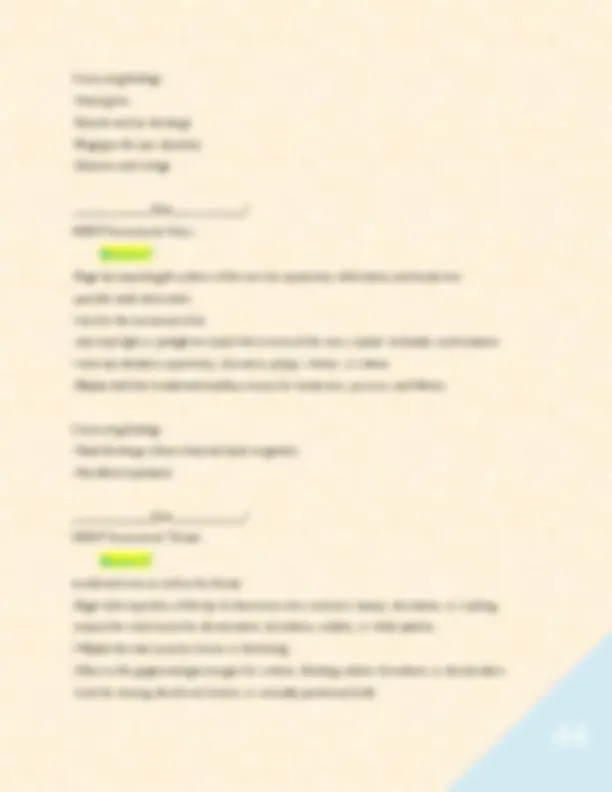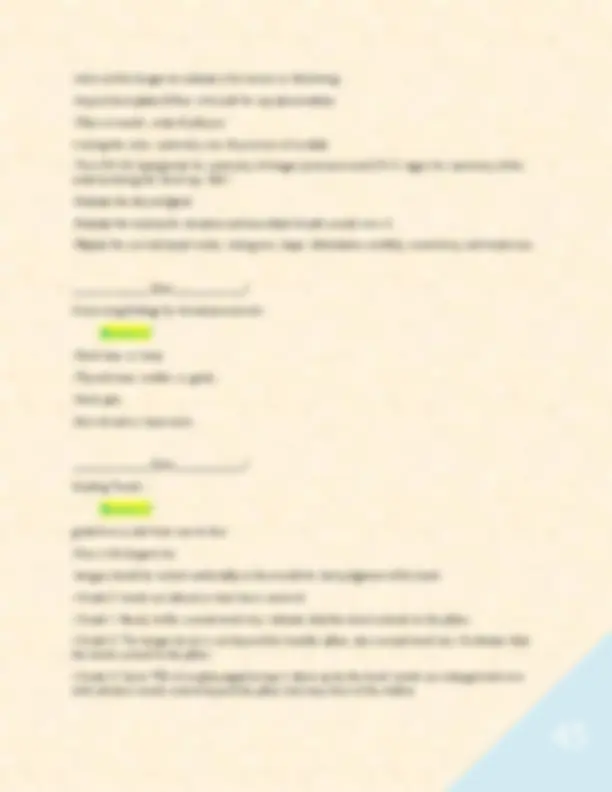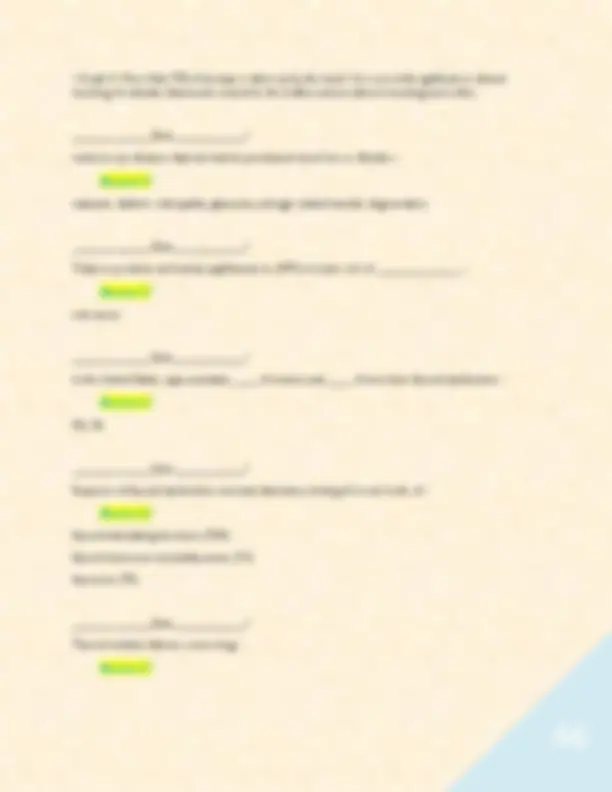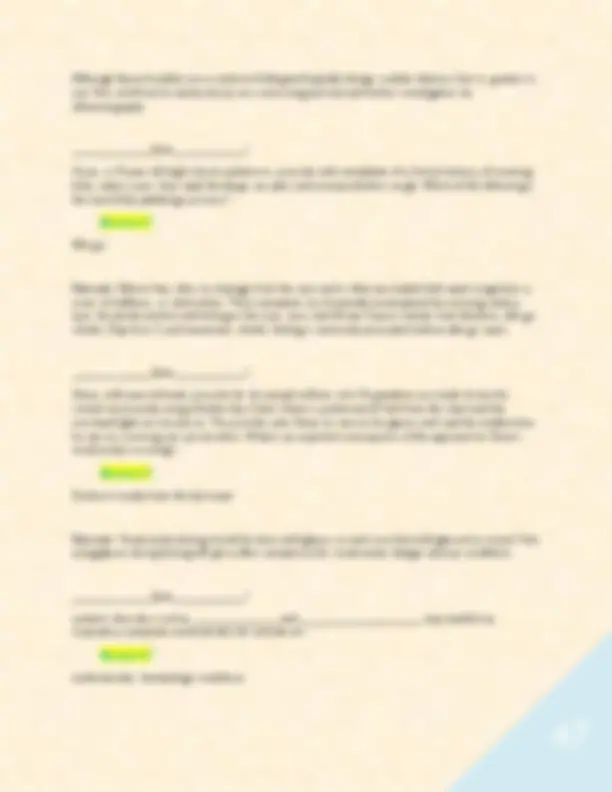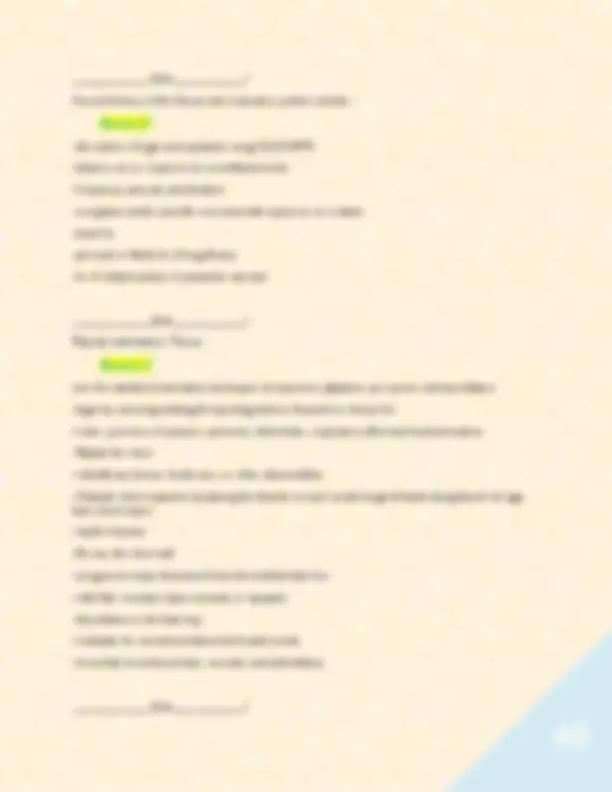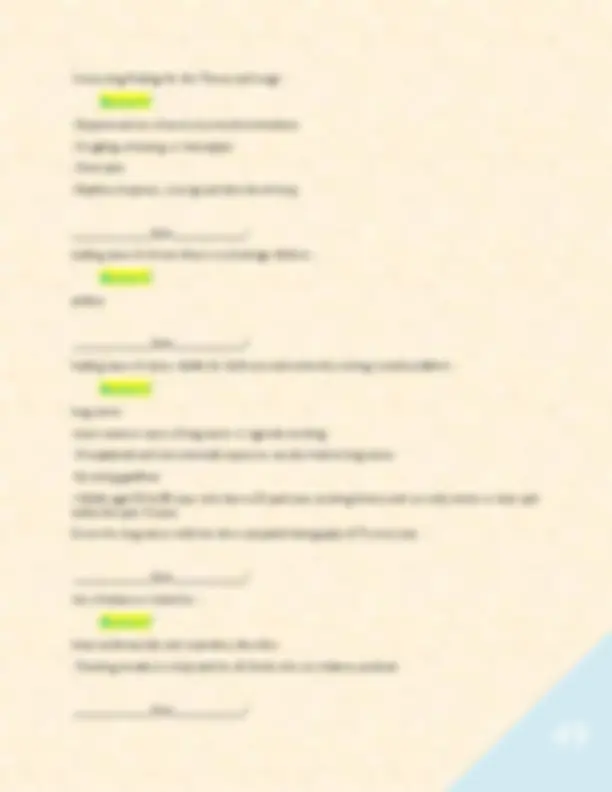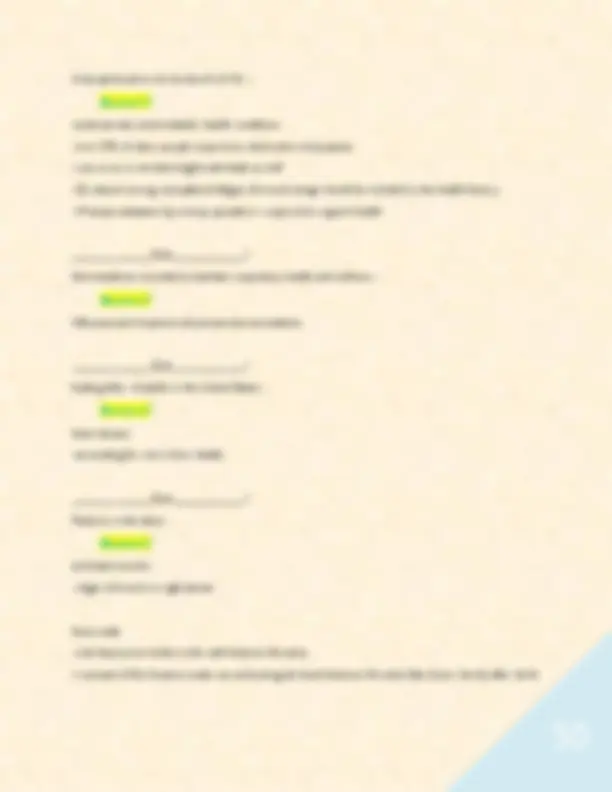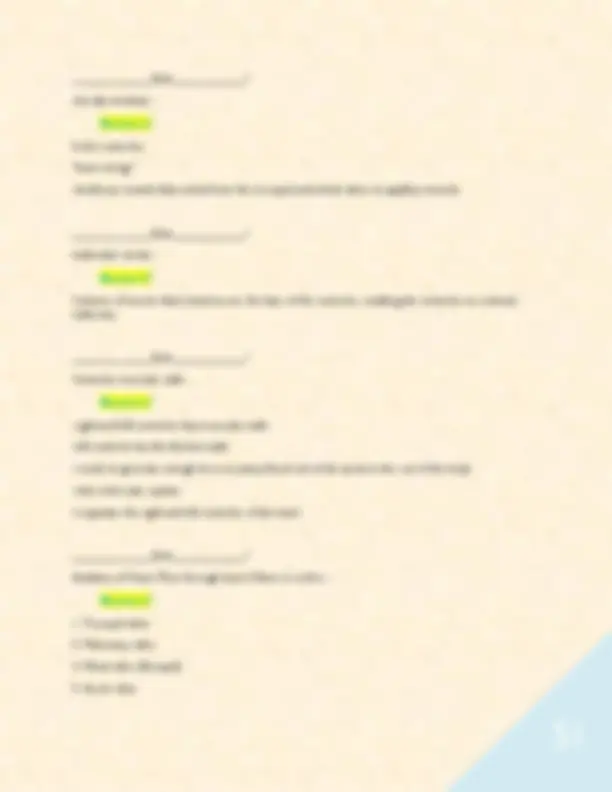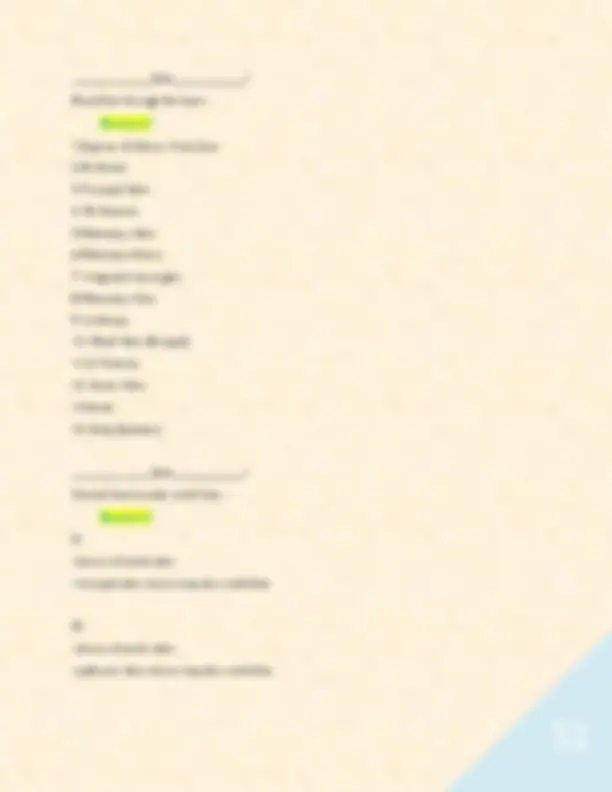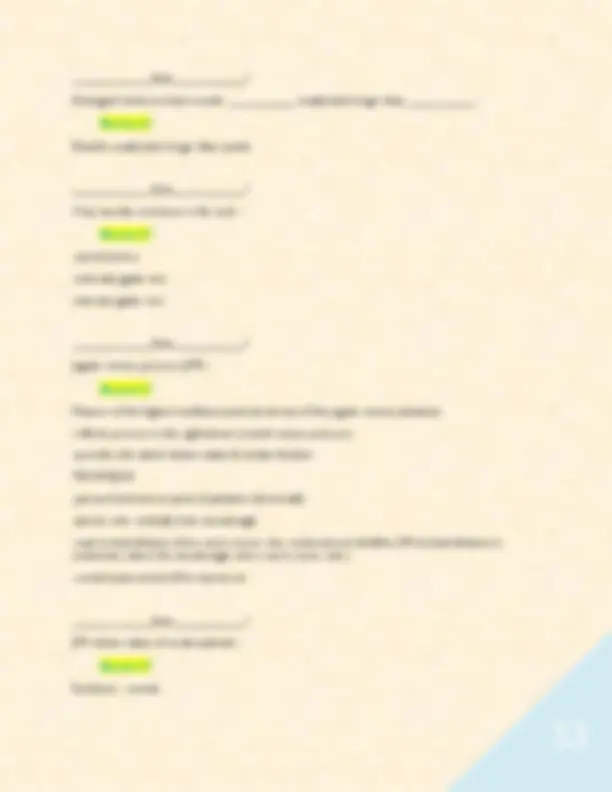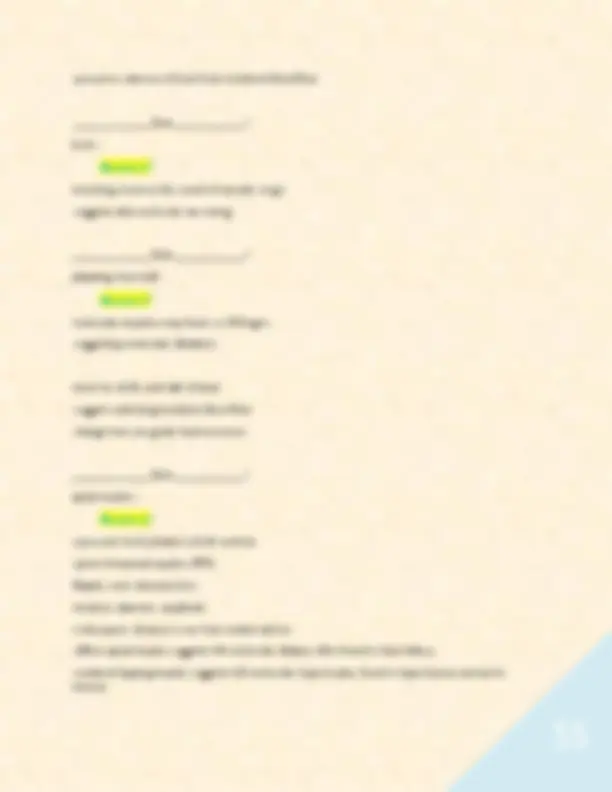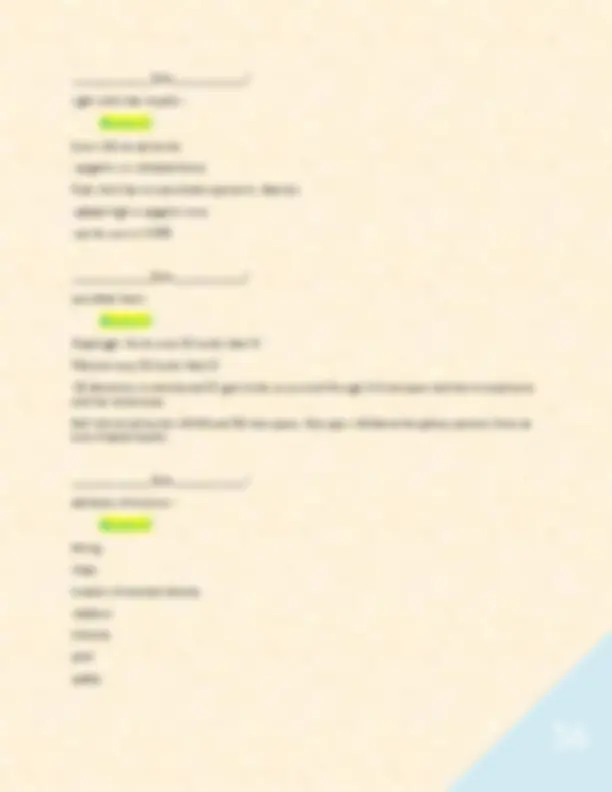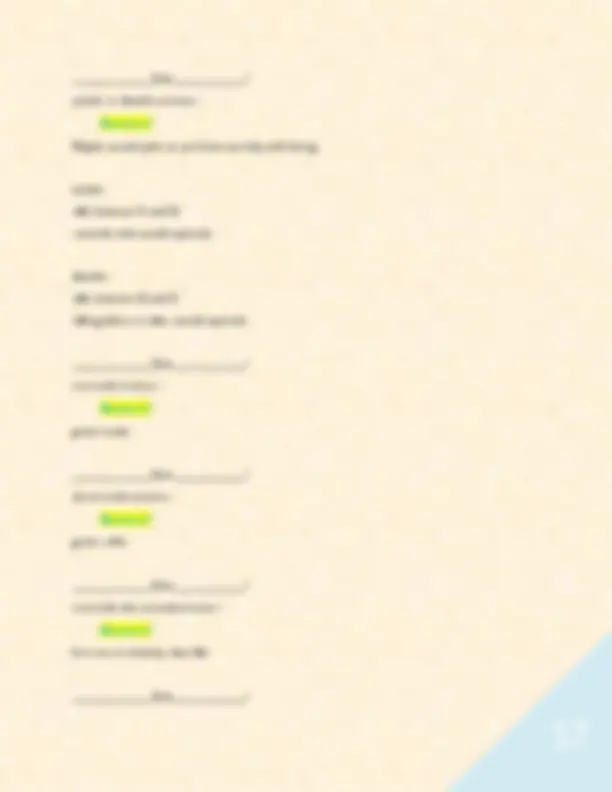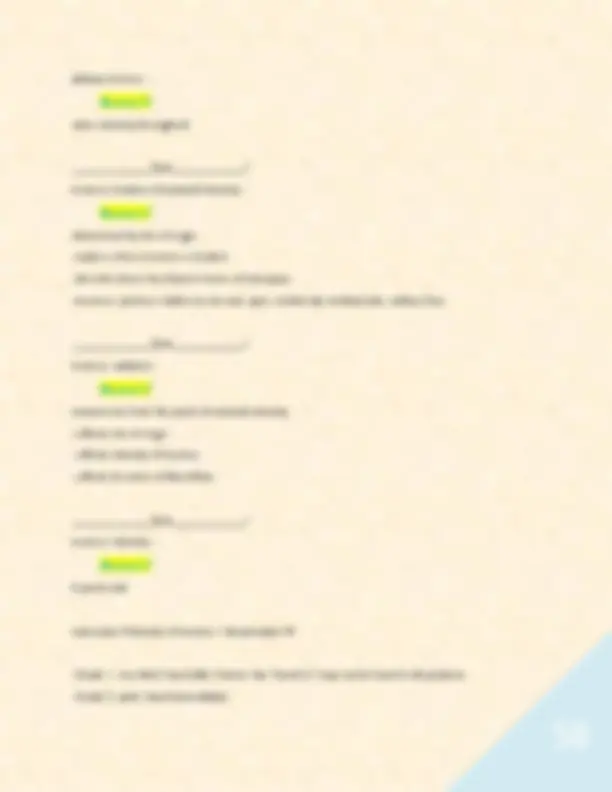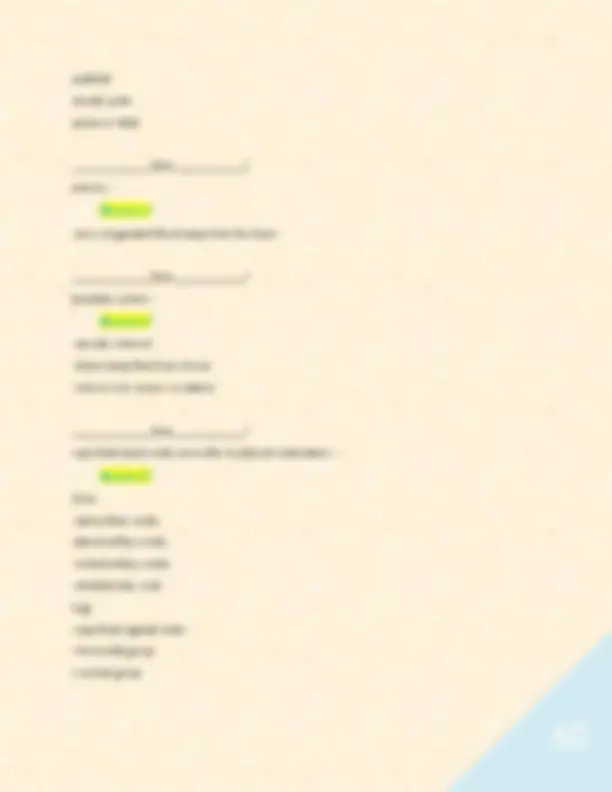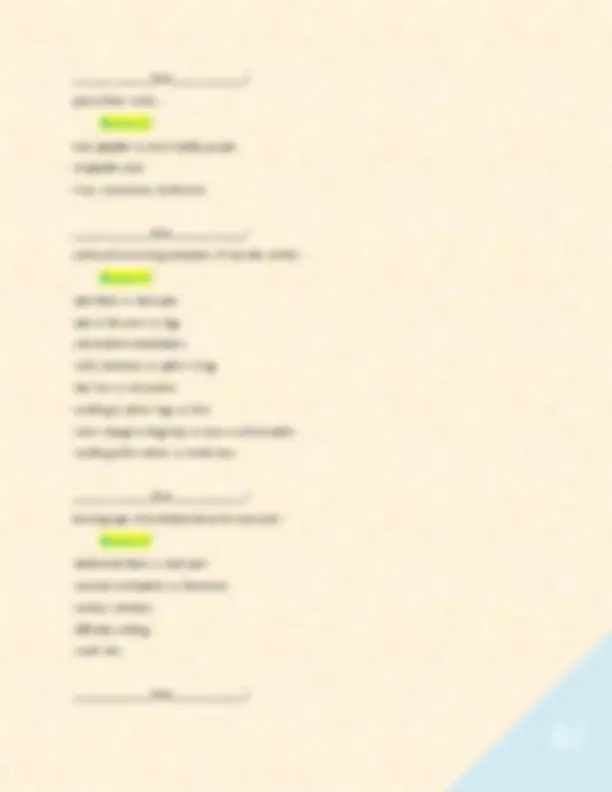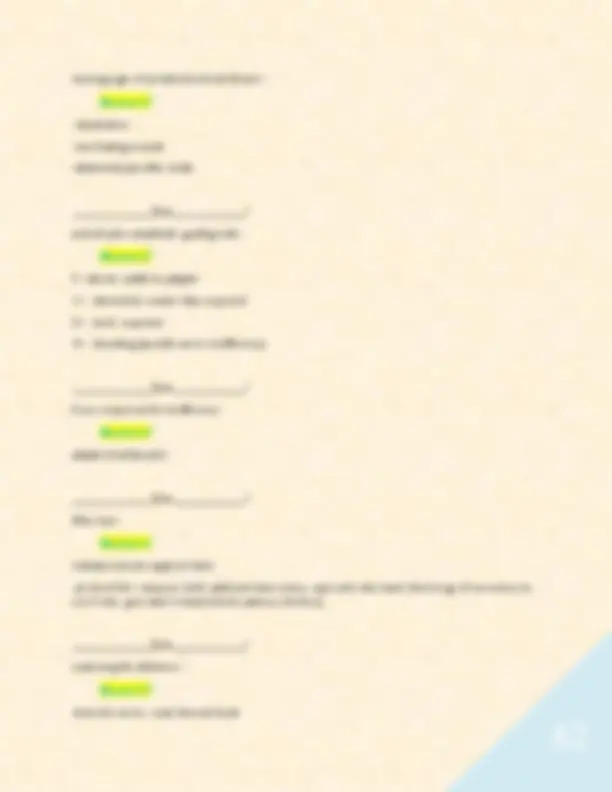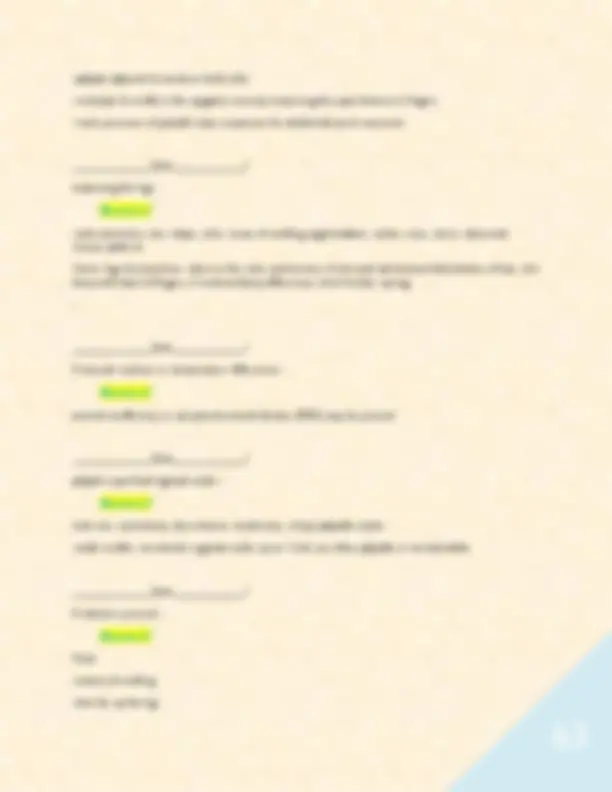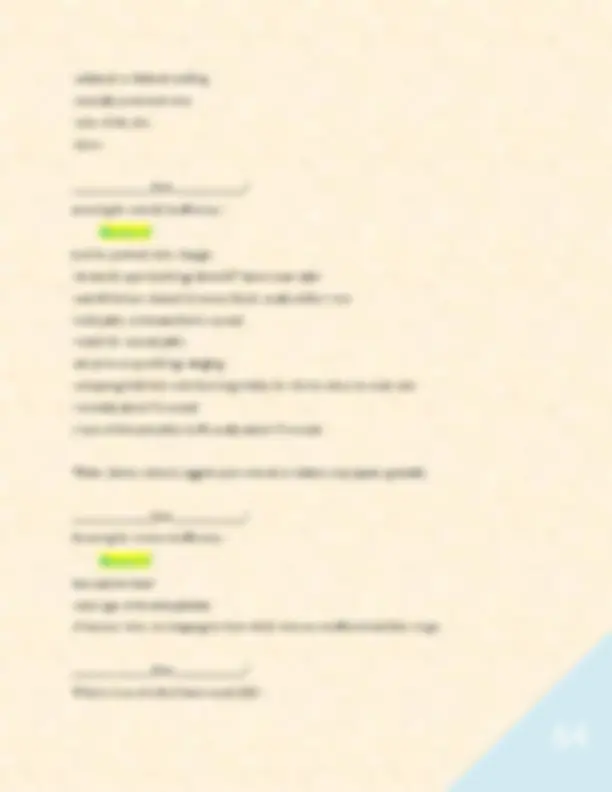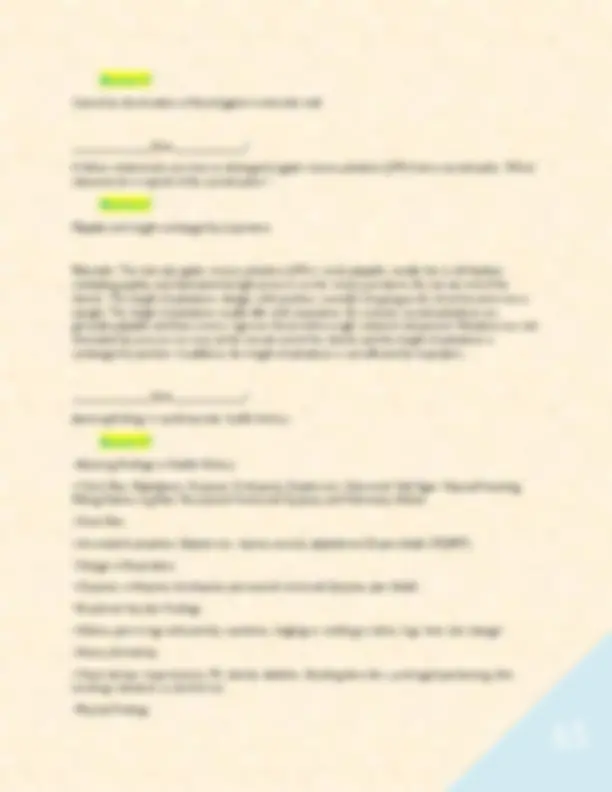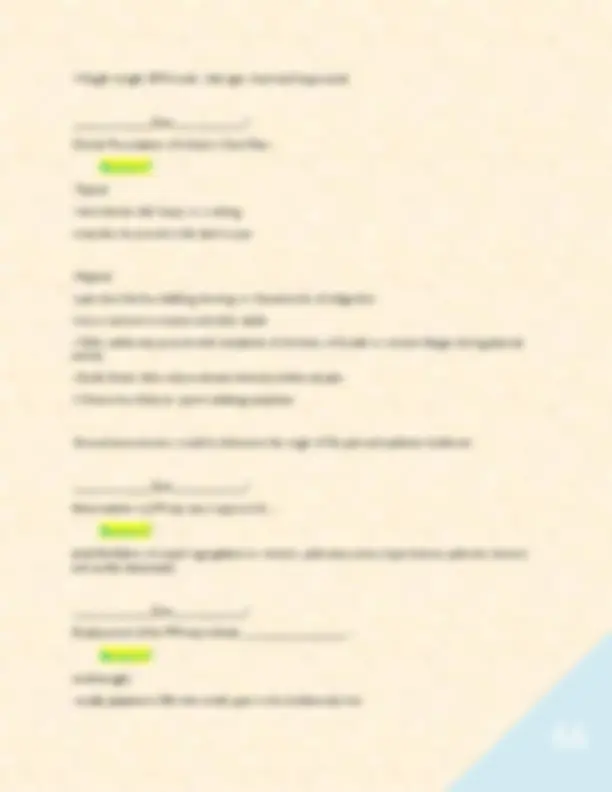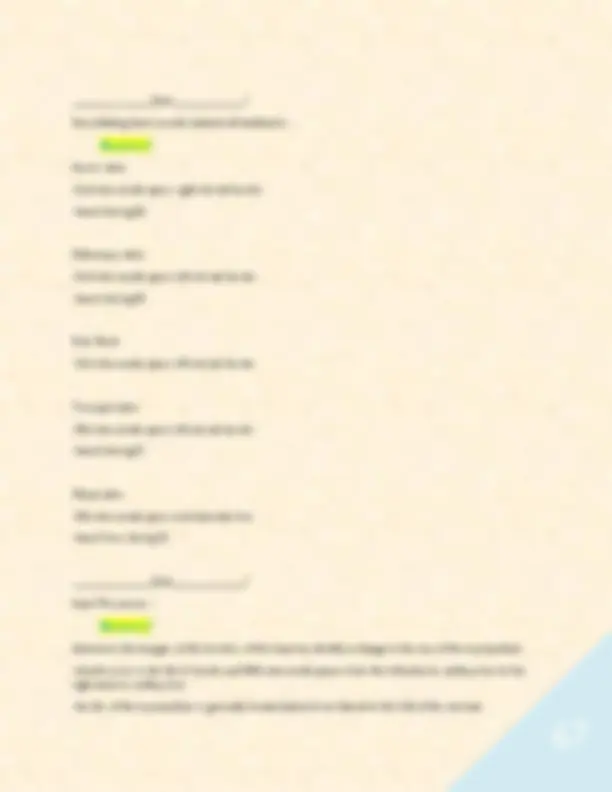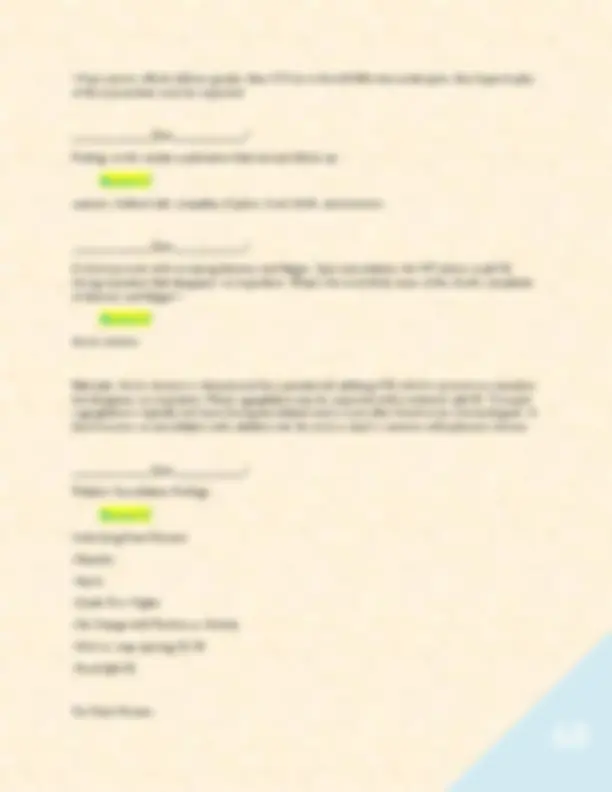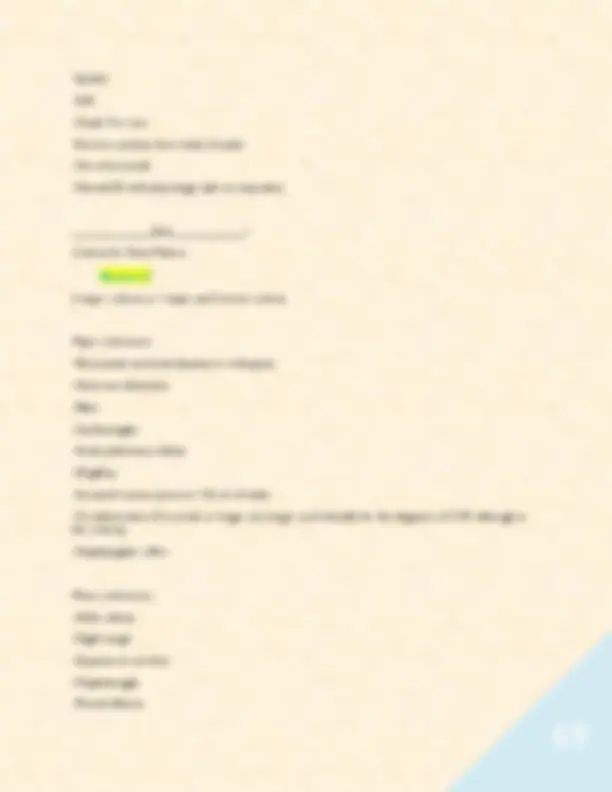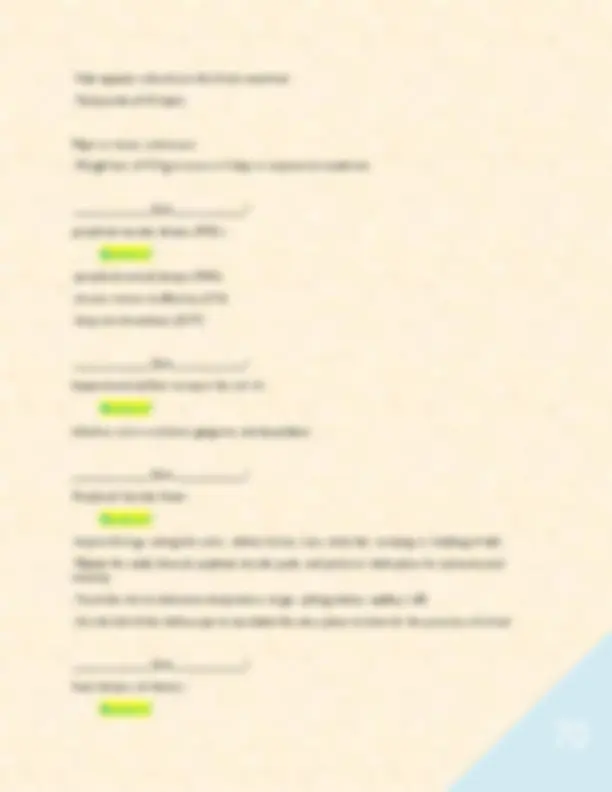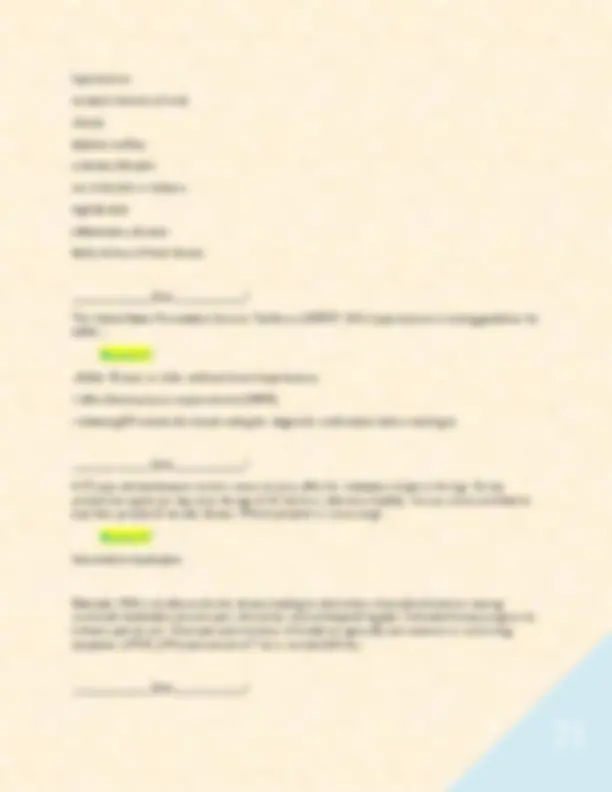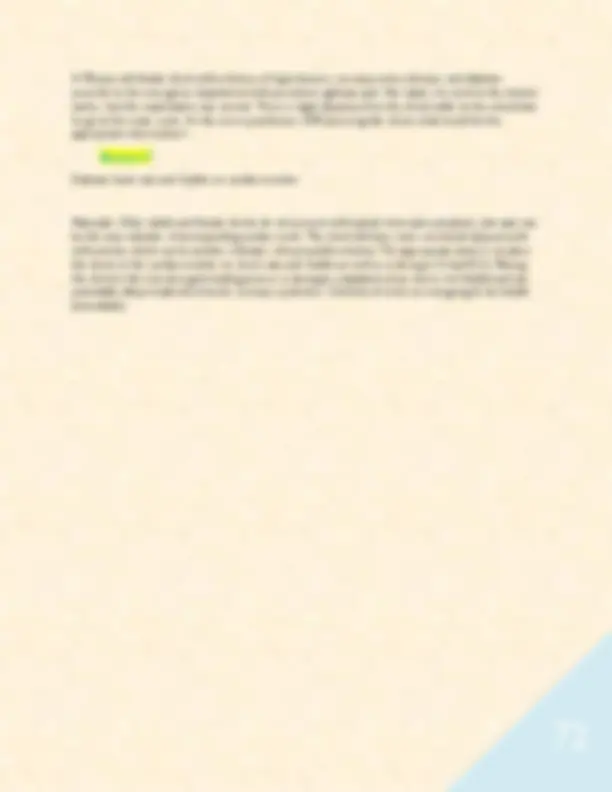Download Midterm Exam NR 509 / NR 509: Comprehensive Study Guide Questions Bank / Actual Questions and more Exams Nursing in PDF only on Docsity!
Midterm Exam NR 509 / NR 509:
Comprehensive Study Guide
Questions Bank / Actual
Questions and Correct Detailed
Answers, 2025/2026.
Terms in this set (218) _____________Quiz____________? Focused Assessment -
Answer ✓✓
- Addresses focused concerns or symptoms
- Used for established clients during routine or urgent care visits
- Health history and physical exams are focused on the problem
- Includes:
- brief history of the present illness
- only the system related to the problem in the review of systems _____________Quiz____________? Comprehensive Assessment -
Answer ✓✓
- Used for new clients
- Provides personalized information about the client
- Strengthens the clinician-client relationship
- Provides a baseline for future assessments
- Provides an opportunity for health promotion education and counseling
- Includes:
- extended history of the present illness
- at least two areas of past medical history, family history, and social history
- at least 10 systems in the review of systems _____________Quiz____________? Subjective data -
Answer ✓✓
includes symptoms that the client describes such as a sore throat, headache, or pain. It also includes the client's feelings, perceptions, and concerns Information obtained from the client during any part of the health history Examples of Subjective Data:
- Lower back pain
- Fatigue
- Stomach cramps
- Immunization history _____________Quiz____________? Objective data -
Answer ✓✓
includes the physical examination findings or signs observed All physical examinations, laboratory information, and test data Examples of Objective Data:
- Heart rate
- Blood pressure
- Lung sounds
- Wound appearance
- Ambulation description
- Weight _____________Quiz____________?
_____________Quiz____________? The general sequence of a clinical encounter is to: -
Answer ✓✓
- initiate the encounter
- gather information
- perform a physical exam
- develop a shared plan
- close the encounter _____________Quiz____________? FIFE mnemonic -
Answer ✓✓
Feelings Ideas Function Expectations
- A mnemonic for the patient's perspective on the illness
- The patient's Feelings, including fears or concerns, about the problem
- The patient's Ideas about the nature and the cause of the problem
- The effect of the problem on the patient's life and Function
- The patient's Expectations of the disease, of the clinician, or of health care, often based on prior personal or family experiences _____________Quiz____________? Basic interviewing techniques -
Answer ✓✓
- guided questioning
- validating
- empowerment
- partnering
- transitioning
- reassuring
- summarizing
- nonverbal communication _____________Quiz____________? active listening -
Answer ✓✓
closely attending to what the client is communicating, connecting to the client's emotional state, and using verbal and nonverbal skills to encourage the client to expand on their feelings and concerns. _____________Quiz____________? empathy -
Answer ✓✓
identifying with the client and feeling their pain as one's own, then responding to them in a supportive manner. _____________Quiz____________? guided questioning -
Answer ✓✓
- Guided questions help to elicit more information, while still showing a continued interest in the client's feelings and story.
- Some techniques of guided questioning include moving from open-ended to more focused questions; clarifying what the client means; encouraging with continuers such as "go on"; using a series of questions one at a time; and using questions that require a graded response (i.e., how many stairs can you climb before feeling short of breath?). _____________Quiz____________?
Answer ✓✓
Giving a summary of the client's story during the interview helps to communicate that they have been carefully listening. _____________Quiz____________? nonverbal communication -
Answer ✓✓
includes eye contact, facial expression, posture, head position, and movement such as shaking or nodding, interpersonal distance, and placement of the arms or legs (i.e., crossed, neutral, or open). _____________Quiz____________? Managing Challenging Situations: Silent Clients -
Answer ✓✓
- Clients may be quiet to collect thoughts, remember details, or decide if they trust the provider
- Become comfortable with periods of silence
- Acknowledge that the client is quiet and ask what they are thinking about or if something has upset them _____________Quiz____________? Managing Challenging Situations: Talkative Clients -
Answer ✓✓
- Talkative clients should be allowed to talk for several minutes at the beginning of the interview
- Focus on what seems to be most important to the client
- Offer a summary of the main concerns and suggest a focus on one problem or ask the client to identify their priority concern for the day _____________Quiz____________? Managing Challenging Situations: Clients with Altered Cognition -
Answer ✓✓
- Clients with conditions such as dementia or mental health illness may not be able to provide their history
- Obtain information from family members or caregivers
- Some clients may be able to provide a history, but cannot make their own health decisions _____________Quiz____________? Managing Challenging Situations: Angry Clients -
Answer ✓✓
- Clients may direct anger toward the provider even if their anger is related to being ill, suffering a loss, or feeling overwhelmed and not in control
- Acknowledge clients' anger and frustration, but avoid reinforcing criticism of other providers or the clinical setting
- Alert security staff for clients who are overly disruptive or out of control
- Remain calm and avoid being confrontational _____________Quiz____________? Comprehensive health history -
Answer ✓✓
Chief Complaint History of Present Illness Past Medical History Medications and Allergies Family History Personal and Social History Review of Systems _____________Quiz____________? History of present illness -
Answer ✓✓
use OLDCARTS _____________Quiz____________?
- subjective
- includes, but is not limited to:
- constitutional
- skin
- head
- eyes
- ears
- nose/sinuses
- allergies
- mouth/throat
- neck
- breast
- respiratory/cardiac
- gastrointestinal
- urinary
- peripheral vascular
- musculoskeletal
- neurological
- hematologic
- endocrine
- psychiatric _____________Quiz____________? Types of review of systems -
Answer ✓✓
- Problem pertinent
- Extended
- reviews between 2-9 systems
- Complete
- minimum of 10 systems
_____________Quiz____________? Social determinants of health -
Answer ✓✓
conditions in the environments where people are born, live, and work that affects health, well-being, and quality of life.
- Healthy physical, social, and economic environments strengthen the potential to achieve health and well-being
- Achieving health and well-being requires eliminating health disparities, achieving health equity, and attaining health literacy
- SDOH:
- Economic Stability
- Education Access and Quality
- Health Care Access and Quality
- Neighborhood and Built Environment
- Social and Community Context _____________Quiz____________? SDOH: Economic Stability -
Answer ✓✓
As a social determinant of health is the relationship between a person's financial resources and their health and wellbeing.
- Financial resources not only include income, but also the cost of living and socioeconomic status.
- Key issues related to economic stability: poverty, employment, food security, and stable housing _____________Quiz____________? SDOH: Education Access and Quality -
Answer ✓✓
as a social determinant of health is the relationship between a person's education and their health and wellbeing.
- Key issues related to education access and quality: graduating from high school, enrollment in higher education, educational attainment, language and literacy, and early childhood education and development
Downstream factors
- specific to individuals
- employment status
- education level
- aspects of identity _____________Quiz____________? Factors that impact client health outcomes -
Answer ✓✓
social determinants of health racism and bias spirituality culture physical and sensory disabilities sexual orientation gender identity _____________Quiz____________? OLDCARTS -
Answer ✓✓
Onset Location Duration Character Aggravating factors Relieving factors Timing & treatments Severity
_____________Quiz____________? Hx taking: 2 main questions to start -
Answer ✓✓
- How can i help you?
- Do you have any other symptoms or concerns we should discuss? _____________Quiz____________? ask all patients their preferred name and gender pronouns, this includes: -
Answer ✓✓
- formal titles such as Mr., Mrs., Ms. or honorifics such as Professor or Doctor
- preferred name may be a nickname, use of a middle name, or some other name altogether
- Except with children or adolescents, avoid first names until you have specific permission
- gender pronouns: him/she and hers/they and theirs. Some of your patients may use nontraditional pronouns. _____________Quiz____________? Implicit bias -
Answer ✓✓
a set of unconscious beliefs or associations that lead to a negative evaluation of a person on the basis of their perceived group identity. _____________Quiz____________? Cultural humility -
Answer ✓✓
- process that requires humility as individuals continually engage in self-reflection and self-critique as lifelong learners and reflective practitioners
- in an effort to address power imbalances and to advocate for others
- the difficult work of examining cultural beliefs and cultural systems of both patients and providers to locate the points of cultural dissonance or synergy that contribute to patients' health outcomes
Nonmaleficence -
Answer ✓✓
("first, do no harm") directive that health care professionals should avoid causing harm to patients and minimize the negative effects of treatments. _____________Quiz____________? Beneficence -
Answer ✓✓
dictum that clinicians are to act for the patients' good by preventing or treating disease.
- intent to do good _____________Quiz____________? Respect for autonomy -
Answer ✓✓
commitment to accept the choices patients with decisional capacity make about which treatments to undergo, including to reject treatment. The addition of this value to medical ethics changed the clinician- patient relationship from a paternalistic one to a more collaborative one. _____________Quiz____________? "Ask Me Three" approach -
Answer ✓✓
intended to help patients become more active members of their healthcare team
- What is my main problem?
- What do I need to do?
- Why is it important for me to do this? *Modifying this approach to "Tell Them Three" can also help clinicians keep their message focused and simple. _____________Quiz____________? Informed Consent -
Answer ✓✓
The following are the required elements for documentation of the informed consent discussion:
- Nature of the procedure or treatment
- Risks and benefits of the procedure or treatment
- Reasonable alternatives
- Risks and benefits of alternatives
- Assessment of the patient's understanding of the first four elements *Clinicians have a legal and ethical duty to follow the process of obtaining consent without leaving out any of the core elements. _____________Quiz____________? SPIKES -
Answer ✓✓
The Six-Step Protocol for Delivering Bad News: S - Setting up the interview P - assessing the patient's Perception I - obtaining the patient's Invitation K - giving Knowledge and information to the patient E - addressing the patient's Emotions with Empathic responses S - Strategy and Summary _____________Quiz____________? Skin Tissue -
Answer ✓✓
body's largest organ, acts as a protective barrier between internal structures and the outside world
- three layers:
- epidermis is the outermost layer of skin and is primarily comprised of keratinocytes—cells that produce the protein keratin. Keratinocytes form the skin's protective barrier and are constantly reproducing to replace old or damaged cells
- Tell me about your current lifestyle including typical diet, smoking, sun exposure, occupation, and hobbies. _____________Quiz____________? Physical examination includes four assessment techniques: -
Answer ✓✓
Inspection = Visual examination Palpation = Tactile examination Auscultation = Auditory examination Percussion = Tactile and auditory examination _____________Quiz____________? Abnormal or Concerning Findings of the Skin, Nails, and Hair -
Answer ✓✓
- Lesions
- Basal Cell Carcinoma
- Melanoma
- Squamous Cell Carcinoma
- Actinic Keratosis
- Rashes & Itching
- Pruritus
- Hair loss
- Nail Changes _____________Quiz____________? Basal Cell Carcinoma -
Answer ✓✓
Epidermal skin cancer Slow progression without pain Occurs in sun-exposed areas
Often on face May ooze, crust, or bleed Refer to dermatology _____________Quiz____________? Melanoma -
Answer ✓✓
- ABCDE assessment
- Asymmetrical
- Border - irregular
- Color - dark or uneven
- Diameter - > 6mm
- Evolution - change in shape, size, and color
- "Ugly duckling" - does not resemble other moles or skin growths on body
- Refer to dermatology _____________Quiz____________? Seborrheic Keratosis -
Answer ✓✓
Noncancerous Develop with advanced age Sharply defined Smooth, waxy, crumbling appearance No treatment required _____________Quiz____________? Actinic Keratosis -
Answer ✓✓
Multiple lesions, varied appearance

